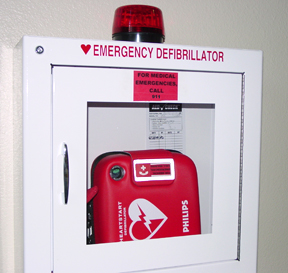 The most common reason for a sudden cardiac arrest is ventricular fibrillation, an arrhythmia that disrupts the heart’s ability to beat and pump blood. While chest-compression-only CPR pumps blood to the brain and other organs, a shock from an AED (automated external defibrillator) is necessary to restore the heartbeat if the device detects a “shockable” rhythm.
The most common reason for a sudden cardiac arrest is ventricular fibrillation, an arrhythmia that disrupts the heart’s ability to beat and pump blood. While chest-compression-only CPR pumps blood to the brain and other organs, a shock from an AED (automated external defibrillator) is necessary to restore the heartbeat if the device detects a “shockable” rhythm.
AEDs are common in public places, such as municipal and commercial buildings, airports, shopping malls, schools, houses of worship and stadiums. It’s worth noting where an AED is located the next time you visit one of these places.
A common misperception about AEDs is that they are to be used only by emergency responders. In fact, the opposite is true. Paramedics arrive at emergency scenes with their own defibrillation equipment. So, if you know where an AED is located, empower yourself to use it if you are helping someone in cardiac arrest.
AEDs provide voice instructions and visual prompts to the bystander who is providing aid, including how to attach the pads to a victim’s bare chest. The device analyzes the person’s heart activity to determine when and if an electric shock should be delivered. Remember, use an AED in conjunction with chest compressions, not instead of them.
When you respond to a cardiac arrest where an AED is available, remember these steps:
- Check for responsiveness—“Shake and shout” and rub the sternum (breast bone) hard with your knuckles.
- Call 911 and retrieve the AED, or ask someone else to.
- Perform fast, forceful chest compressions until the AED is activated. If the AED tells you to do so, press the button to deliver a shock.
- After the shock continue chest compressions (at a rate of 100 a minute) for two more minutes. Continue doing 200 chest compressions followed by the AED assessment until, the patient is revived or medical assistance arrives.

